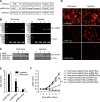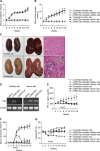Long-term and stable correction of uremic anemia by intramuscular injection of plasmids containing hypoxia-regulated system of erythropoietin expression
- PMID: 22990115
- PMCID: PMC3509184
- DOI: 10.3858/emm.2012.44.11.076
Long-term and stable correction of uremic anemia by intramuscular injection of plasmids containing hypoxia-regulated system of erythropoietin expression
Abstract
Relative deficiency in production of glycoprotein hormone erythropoietin (Epo) is a major cause of renal anemia. This study planned to investigate whether the hypoxia-regulated system of Epo expression, constructed by fusing Epo gene to the chimeric phosphoglycerate kinase (PGK) hypoxia response elements (HRE) in combination with cytomegalovirus immediate- early (CMV IE) basal gene promoter and delivered by plasmid intramuscular injection, might provide a long-term physiologically regulated Epo secretion expression to correct the anemia in adenine-induced uremic rats. Plasmid vectors (pHRE-Epo) were synthesized by fusing human Epo cDNA to the HRE/CMV promoter. Hypoxia-inducible activity of this promoter was evaluated first in vitro and then in vivo in healthy and uremic rats (n = 30 per group). The vectors (pCMV-Epo) in which Epo expression was directed by a constitutive CMV gene promoter served as control. ANOVA and Student's t-test were used to analyze between- group differences. A high-level expression of Epo was induced by hypoxia in vitro and in vivo. Though both pHRE-Epo and pCMV-Epo corrected anemia, the hematocrit of the pCMV-Epo-treated rats exceeded the normal (P < 0.05), but that of the pHRE-Epo-treated rats didn't. Hypoxia-regulated system of Epo gene expression constructed by fusing Epo to the HRE/CMV promoter and delivered by plasmid intramuscular injection may provide a long-term and stable Epo expression and secretion in vivo to correct the anemia in adenine-induced uremic rats.
Figures



Similar articles
-
Long-term reversal of chronic anemia using a hypoxia-regulated erythropoietin gene therapy.Blood. 2002 Oct 1;100(7):2406-13. doi: 10.1182/blood-2002-02-0605. Blood. 2002. PMID: 12239150
-
Indoxyl sulfate, a representative uremic toxin, suppresses erythropoietin production in a HIF-dependent manner.Lab Invest. 2011 Nov;91(11):1564-71. doi: 10.1038/labinvest.2011.114. Epub 2011 Aug 22. Lab Invest. 2011. PMID: 21863063
-
Gene electrotransfer results in a high-level transduction of rat skeletal muscle and corrects anemia of renal failure.Hum Gene Ther. 2000 Sep 1;11(13):1891-900. doi: 10.1089/10430340050129503. Hum Gene Ther. 2000. PMID: 10986561
-
Effects of erythropoietin-gene electrotransfer in rats with adenine-induced renal failure.Am J Nephrol. 2003 Sep-Oct;23(5):315-23. doi: 10.1159/000072913. Epub 2003 Aug 12. Am J Nephrol. 2003. PMID: 12915775
-
Correction of anemia in uremic rats by intramuscular injection of lentivirus carrying an erythropoietin gene.Am J Nephrol. 2006;26(4):326-34. doi: 10.1159/000094401. Epub 2006 Jul 5. Am J Nephrol. 2006. PMID: 16825758
Cited by
-
Characterization of neural stem cells modified with hypoxia/neuron-specific VEGF expression system for spinal cord injury.Gene Ther. 2018 Jan;25(1):27-38. doi: 10.1038/gt.2017.92. Epub 2017 Nov 20. Gene Ther. 2018. PMID: 29155421
-
The prognostic roles of red blood cell-associated indicators in patients with resectable gastric cancers.Transl Cancer Res. 2020 Apr;9(4):2300-2311. doi: 10.21037/tcr.2020.03.46. Transl Cancer Res. 2020. PMID: 35117591 Free PMC article.
-
Pretreatment Hematocrit Is Superior to Hemoglobin as a Prognostic Factor for Triple Negative Breast Cancer.PLoS One. 2016 Nov 16;11(11):e0165133. doi: 10.1371/journal.pone.0165133. eCollection 2016. PLoS One. 2016. PMID: 27851755 Free PMC article.
References
-
- Acs G, Acs P, Beckwith SM, Pitts RL, Clements E, Wong K, Verma A. Erythropoietin and erythropoietin receptor expression in human cancer. Cancer Res. 2001;61:3561–3565. - PubMed
-
- Acs G, Zhang PJ, McGrath CM, Acs P, McBroom J, Mohyeldin A, Liu S, Lu H, Verma A. Hypoxia-inducible erythropoietin signaling in squamous dysplasia and squamous cell carcinoma of the uterine cervix and its potential role in cervical carcinogenesis and tumor progression. Am J Pathol. 2003;162:1789–1806. - PMC - PubMed
-
- Arcasoy MO, Amin K, Vollmer RT, Jiang X, Demark-Wahnefried W, Haroon ZA. Erythropoietin and erythropoietin receptor expression in human prostate cancer. Mod Pathol. 2005;18:421–430. - PubMed
-
- Ataka K, Maruyama H, Neichi T, Miyazaki J, Gejyo F. Effects of erythropoietin-gene electrotransfer in rats with adenine-induced renal failure. Am J Nephrol. 2003;23:315–323. - PubMed
-
- Bennett CL, Luminari S, Nissenson AR, Tallman MS, Klinge SA, McWilliams N, McKoy JM, Kim B, Lyons EA, Trifilio SM, Raisch DW, Evens AM, Kuzel TM, Schumock GT, Belknap SM, Locatelli F, Rossert J, Casadevall N. Pure red-cell aplasia and epoetin therapy. N Engl J Med. 2004;351:1403–1408. - PubMed
Publication types
MeSH terms
Substances
LinkOut - more resources
Full Text Sources
Medical
Research Materials
